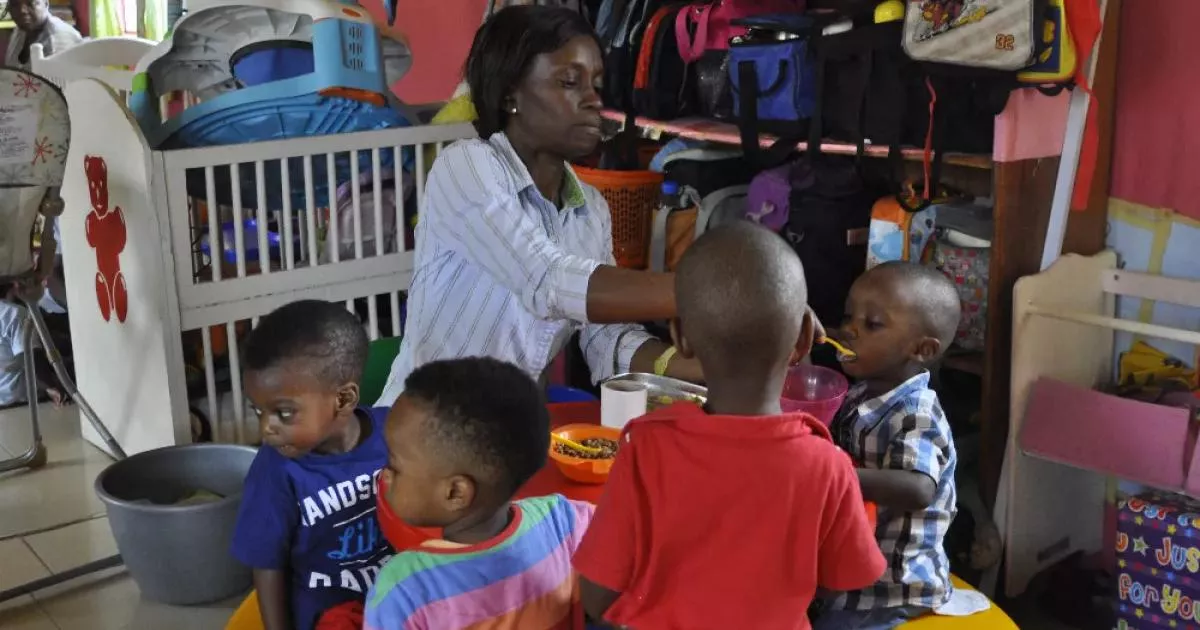Child care, also known as day care, involves the supervision and care of children, usually from three months to 18 years old, by non-parental caregivers. Encompassing a diverse range of professionals, institutions, contexts, and activities, it's a broad field influenced by social and cultural norms. Early childcare significantly contributes to a child's overall development and is often a vital, yet underestimated, aspect of raising children.
1969: Absence of cross-cultural research on childcare
By 1969, there had been no crosscultural work reference to caretaking of children by anyone other than parents published in The Handbook of Socialization Theory and Research.
1971: Comprehensive Child Development Act vetoed by President Nixon
In 1971, the Comprehensive Child Development Act, which proposed nationally funded childcare centers providing various services on a sliding scale, was passed by Congress but vetoed by President Richard Nixon. This marked a significant setback in the effort to establish a national policy supporting daycare in the United States.
1977: Thomas S. Weisner and Ronald G. Gallimore article on childcare
In 1977, Thomas S. Weisner and Ronald G. Gallimore reported on their study of over a hundred countries. They found that in agricultural/ horticultural societies where work is done to provide sustenance for the community, siblings and similar-aged children are responsible for younger children.
1990: Child Care and Development Block Grant Act enacted
In 1990, the Child Care and Development Block Grant Act was enacted as part of the Omnibus Budget Reconciliation Act. This act created a dedicated federal funding stream for childcare subsidies to support low-income families, marking a significant milestone in federal support for childcare in the United States.
1995: U.S. Census Bureau Survey on Childcare
According to the 1995 U.S. Census Bureau Survey of Income and Program Participation (SIPP), over 36% of families of preschoolers with working mothers primarily relied on childcare in the home of a relative, family daycare provider or other non-relative.
1996: Personal Responsibility and Work Opportunity Reconciliation Act passed
In 1996, the 104th Congress passed The Personal Responsibility and Work Opportunity Reconciliation Act of 1996 (PRWORA), consolidating three federal child care programs previously serving low-income families under the program formerly known as Aid to Families with Dependent Children.
1997: WHO Study of Developing Nations
Since 1997, the World Health Organization (WHO) has conducted an extensive study of six developing nations to develop standards known as the New WHO Child Growth Standard and measure the physical growth, nutritional status, and motor development of children from birth to 5 years of age.
1998: Child Care Development Fund subsidy
Working families at or near the poverty line did not receive any or enough child care assistance to be able to stay employed and off welfare, and only 12% to 15% of eligible families were served by a Child Care Development Fund subsidy in 1998–1999.
1999: Canadian Child Care Survey
In 1999, a Canadian survey of formal child care centers found that labor accounted for 63% of costs and the industry had an average profit of 5.3%. The 1999 survey also indicated little economies of scale between larger and smaller operators due to the labor-intensive nature of the industry.
1999: Child care worker statistics in Canada and the U.S.
In 1999, the workforce in Canadian child care was predominantly female (95%) and low paid, averaging only 60% of the average workforce wage. In the United States in 1999, "child care worker" was the fifth most female-dominated occupation (95.5% female).
1999: Child Care Development Fund subsidy
Working families at or near the poverty line did not receive any or enough child care assistance to be able to stay employed and off welfare, and only 12% to 15% of eligible families were served by a Child Care Development Fund subsidy in 1998–1999.
2000: US Studies on the effects of Good Daycare
In 2000, several studies in the United States indicated that good daycare for non-infants is not harmful and can provide different experiences than parental care, especially for children two years old and older.
2001: More than half of children in the United States attend childcare facilities
As of 2001, over half of the children in the United States were attending childcare facilities. This increase correlated with the rise in the number of working parents, leading to increased demand for childcare services.
2001: Child care an important aspect of American society
By 2001, child care had become an important aspect of American society, with more than "thirteen million American children under 5 years of age experiencing some form of child care before entering formal school."
2001: The Public Agenda research on childcare
In 2001, The Public Agenda undertook research on childcare in the United States.
2003: Almost 26% of families used organized childcare facilities
By 2003, almost 26% of families used organized childcare facilities as their primary arrangement.
2003: American Study on Time Spent in Daycare
In 2003, an American study in Child Development indicated that time spent in daycare before age four-and-a-half tended to correspond with a child's tendency to be less likely to get along with others, to be disobedient, and to be aggressive, although still within the normal range.
2003: IRS Child and Dependent Care Credit information
In 2003, the IRS provided Child and Dependent Care Credit information in the United States.
2006: New Zealand uses learning stories as a learning model
By 2006, New Zealand began to use learning stories as a learning model in their curriculum called "Te Whaariki". It highlights children's learning outcomes as 'disposition' which are "situated learning strategies plus motivation-participation repertoires from which a learner recognize, selects, edits, responds to, resists, searches for and constructs learning opportunities".
2006: University of Florida's Department of Family, Youth and Community Sciences (IFAS) research on childcare
In 2006, the University of Florida's Department of Family, Youth and Community Sciences (IFAS) undertook research on childcare in the United States.
2007: National Institute of Child Health Development survey
A 2007 National Institute of Child Health Development survey indicated the lack in quality of American healthcare centers.
2007: US Studies on the effects of Good Daycare
By 2007, studies in the United States found that higher quality child care was associated with better language and cognitive development during the first 4 1/2 years of life. Children in higher quality care were also more cooperative than those who experienced lower quality care during the first 3 years of life.
2007: Ministry of Social Development creates childcare program
In 2007, the Ministry of Social Development in Mexico created a childcare program specifically targeting low-income families and mothers not covered by social security services. To be eligible, mothers had to be working or seeking employment, have a low income compared to minimum wage, and lack access to other childcare services. This initiative aimed to directly address the needs of vulnerable families and increase women's participation in the workforce.
2007: Federal Daycare Programme for Working Mothers
In 2007, the creation of The Federal Daycare Programme for Working Mothers allowed for subsidized home and community based childcare. The care center owners only had to have a training component, which consisted of a psychological test and training courses to understand the principles of childcare, before opening their business, which was then given money to furnish the facility. Another way this program was set into place was by subsidizing the care of non-profits, private for profits, or religious institutions who were based in the area of need.
2007: National Institute of Health Study Results
In March 2007, the National Institute of Health released a study that followed children through early childhood to the 6th grade, and found that children who received higher quality of childcare scored higher on 5th grade vocabulary tests. The 2007 study also reported that teachers found children from childcare to be more "disobedient", fight more frequently, and more argumentative, though increases in both aggression and vocabulary were small and behavior was within the normal range.
2008: Not-for-profits and Quality of Care
In 2008, an article in The Star stated that not-for-profit organizations are much more likely to produce high quality child care environments.
2008: GOI Adopts WHO Standards
In 2008, the Government of India (GOI) adopted the World Health Organization standards for measuring and monitoring child growth and development, both for the ICDS and the National Rural Health Mission (NRHM).
2009: The National Child Care Information and Technical Assistance Center (NCCIC) research on childcare
In 2009, The National Child Care Information and Technical Assistance Center (NCCIC) undertook research on childcare in the United States.
2011: Child care costs increased
Between 2011 and 2012, the cost of child care increased at up to eight times the rate of increases in family income in the United States. Lower income families were disproportionately affected by these increases in child care costs.
2011: Government guarantees daycare for children at least 1 year old
In 2011, the government of Norway guaranteed daycare for all children that are at least 1 year old by August 1st. While coverage was not yet 100%, most regions were approaching that level. The government also established a maximum price for daycare to ensure it remained affordable for all families.
2012: Child care costs increased
Between 2011 and 2012, the cost of child care increased at up to eight times the rate of increases in family income in the United States. Lower income families were disproportionately affected by these increases in child care costs.
2012: Head Start lead teachers must have a bachelor's degree
By 2012, all lead teachers in Head Start programs in the United States were required to have a bachelor's degree in Early Childhood Education, marking a milestone in the professionalization of the field. This requirement aimed to improve the quality of care and education provided to children in these programs.
2013: "The Hell of American Day Care" article
In 2013, "The Hell of American Day Care", a cover story in The New Republic, highlighted the potential benefits and harms related to formal child care in the United States. It suggested the quality of institutions and programs is inferior to those in other countries.
2013: Cost of Childcare in Australia
In 2013, the median weekly cost of center-based long day care in Australia was approximately A$364, which puts it out of the reach of lower income earners.
March 2014: U.S. Senate passed reauthorization of the Child Care and Development Block Grant program
In March 2014, the U.S. Senate passed a reauthorization of the Child Care and Development Block Grant program that included some baseline changes to ensure safe child care. Child Care Aware of America supported the bill.
September 2014: House and Senate reach bipartisan agreement to reauthorize the Child Care and Development Block Grant Act
On 12 September 2014, House and Senate leaders reached a bipartisan agreement to reauthorize the Child Care and Development Block Grant Act to enhance transparency, strengthen health and safety protections, and improve the quality of care. The U.S. House of Representatives passed the amended version of the bill on 15 September 2014.
November 2014: President Obama signs Child Care and Development Block Grant Act of 2014 into law
On 19 November 2014, President Barack Obama signed S.1086, the Child Care and Development Block Grant Act of 2014, into law, solidifying federal support for childcare and development programs.
2017: HiMama Survey on Child Care Risks and Priorities
According to a survey done by HiMama in 2017, 68% of for-profit child care organizations ranked 'Labor' as their top risk and 65% ranked 'Talent and Recruitment' as their top priority.
2018: Cost of Free Childcare in India
In 2018–19 fiscal year, free childcare in India cost the state ₹28,335 crore (US$3.4 billion).
April 2019: Childcare Waitlist Statistics in Japan
As of April 2019, Okinawa had the highest percentage of children on the waitlist at 2.8% of all the applicants (1,702 children), while Tokyo had the largest number of children on the waitlist at 3,690 children (1.19% of applicants).
2020: Cost of child care increasing
In 2024, the average annual cost of center-based child care for one child was $13,128, a 29% increase from 2020. For a married couple with children earning the median household income, child care for one child accounted for approximately 10% of their income, while for a single parent, it represented about 35%.
2021: Educator to Child Ratios in Australia
As of 2021, minimum supervision ratios of educators to children in Australia were 1:4 for infants, 1:5 for 2–3 years old (except for VIC – 1:4), 1:10 for preschoolers in NSW, TAS and WA, and 1:11 for preschoolers in ACT, NT, QLD, SA and VIC.
2021: Canadian Government Investment in Child Care
In 2021, the Canadian government, reflecting on the circumstances of the COVID-19 pandemic, made it a goal to decrease the cost of child care and invested up to $8.3 billion for child care services for early learning and for indigenous communities.
2024: Cost of child care increasing
In 2024, the average annual cost of center-based child care for one child was $13,128, a 29% increase from 2020. For a married couple with children earning the median household income, child care for one child accounted for approximately 10% of their income, while for a single parent, it represented about 35%.
2025: New Mexico offers free child care to all families
In 2025, New Mexico became the first state to offer free child care to all families, marking a significant step towards universal childcare access.
Mentioned in this timeline

Barack Obama the th U S President - was the...
New Zealand is an island country located in the southwestern...
India officially the Republic of India is a South Asian...
Japan is an East Asian island country situated in the...
Australia officially the Commonwealth of Australia encompasses the Australian mainland...
Florida a state in the Southeastern United States is largely...
Trending
7 days ago Mortgage Rates Fall: Refinance Opportunities and Lender Options Emerge in December 2025

6 months ago Victor Wembanyama sports shaved head at Shaolin Temple; Draymond Green reacts.

1 month ago Warriors' Commitment Questioned After Loss; Green, Butler Criticize Teammates; Curry's Reaction?
8 days ago Cameron Crowe's 'The Uncool': A Cool Backstage Pass to Music History & Cringe

De'Anthony Melton known as Mr Do Something is a professional basketball player in the NBA currently playing for the Brooklyn...

14 days ago Childcare's economic boost in Prescott Valley, Yavapai crisis, and Hochul's universal options.
Popular

Candace Owens is an American conservative political commentator and author...

Ilhan Omar is an American politician currently serving as the...

XXXTentacion born Jahseh Dwayne Ricardo Onfroy was a controversial yet...

Tom Cotton is an American politician and Army veteran currently...
Matt and Ross Duffer known as the Duffer Brothers are...
The Kennedy Center Honors are annual awards recognizing individuals and...
